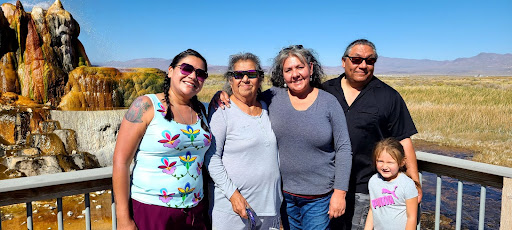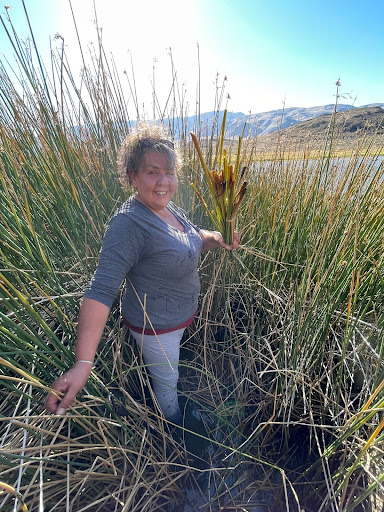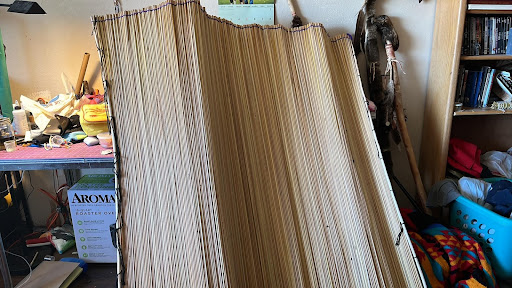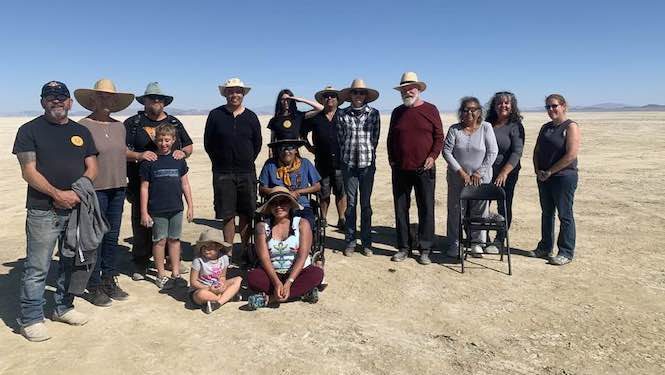Black Rock City rises each year on the ancestral land of the Pyramid Lake Paiute Tribe and the Fallon Paiute-Shoshone Tribe. Over the years, there have been many voices and conversations in favor of organizing a land acknowledgement and blessing prior to building Black Rock City. In 2019 Marnee Benson, Burning Man Project’s Director of Government Affairs, was among many moved by a Black Rock City Temple blessing. It served as her inspiration to convene a pre-event blessing prior to the 2022 event. Melissa ‘Hormel’ Waters participated in that blessing; here Melissa shares her experience of the post-event closing ritual.
I am a little surprised to see so much dust billow up behind our car as we drive off the highway and onto the empty playa. We had heard there had been a significant rainfall during Playa Restoration and I thought the playa surface would be more solid. The cars following us veer upwind to avoid the worst of it, and we set our course straight towards what was once where the Man stood.
I am driving with my family, Tony Perez-Banuet (Coyote), and one of my twin sons, Colby. Coyote is the City Superintendent of Black Rock City; he has been charged with finding the center of our ephemeral Home. Dodging our dust are Cultural Co-founders Will Roger and Crimson Rose, and friends from the local Pyramid Lake Paiute and Fallon Paiute-Shoshone Tribes.
We’re headed to our second playa blessing ceremony of the year. The first had been in late July, coinciding with our first day of event site work and the Golden Spike, the opening ceremony for crews who build Black Rock City.
We were now finished with our work on the playa for the year, the Bureau of Land Management site inspection having been conducted two days prior, and were returning to the center of the city to express our gratitude and release the event site from our dusty grasp. Soon the winter rains will come and the playa will be impassable, host to many emerging fairy shrimp and a handful of unwitting and unfortunately immobilized travelers.
On this day, the playa was hosting a dozen or so humans, a delightful mix of young and old, Burning Man staff, and tribal members of the Pyramid Lake Paiute Tribe and the Fallon Paiute-Shoshone Tribe. The playa is part of their ancestral land, home to the Numu Paiute people for more than 14,000 years. The Black Rock playa is surrounded by historically significant sites for the Paiutes, land that holds memories of successful hunts, happy homes, foraged foods, and unthinkable tragedies.
Dean Barlese, tribal elder and cultural and spiritual advisor for the Pyramid Lake Reservation, remembers visiting the playa as a child to offer prayers and learn the history of his people and this land from his parents. Sacred burial sites pepper the mountains around the playa valley, Dean tells us reverently during ceremony, nodding towards the Black Rock to the north.
We share Dean’s pipe and golden eagle feather, blessing ourselves and the land on which we stand. We speak of a shared commitment to honor the earth, of mutual stewardship of the desert that we love, and of shared friendships being forged through ritual.

Dean is himself a Burner, a participant since 2001, where he has been blessing the Temple for many years. He has with him three family members from Nixon, Misty Youngbear (Meskwaki/Omaha), Keenyn Reed (Klamath), Amarah Gibson (Pyramid Lake Paiute) and from Fallon, Donna Cossette (Northern Paiute) and her mother Carol Sanders (Northern Paiute).
After the playa blessing ceremony in July, Steve Cabrera, aka Cherub, took Dean for a tour of Fly Ranch, just north of the playa. While there Dean noticed an abundance of tule, a culturally significant plant for the Paiutes, and asked for permission to return and harvest. Much of the habitat for tule has been eliminated or destroyed by agricultural runoff, wetland destruction, or grazing, making the bountiful and pollutant-free shorelines at Fly Ranch a treasure trove of tule, cattails, and rushes, all important to the Paiute people for various purposes.
Dean had asked Donna and her mother Carol to join in the harvest, as they use the tule to make traditional burial mats for repatriated remains. Donna, Keenyn, and Dean have worked together for more than 30 years to reclaim human remains and cultural artifacts from museums and scientific institutions, as well as those accidentally uncovered through the course of farming or construction. The tule that we harvest this day will be used to make three mats for remains being returned to the Tribe after being accidentally uncovered during excavation.

Knowing the intended purpose of our harvest lends significance to our work. As Donna sharpens her curved-blade cutting tools, I head out with Lisa Beers (Scirpus), Fly Ranch Fellow and PhD wetlands researcher, to ensure an accessible harvest location and to find the type of tule that Donna needs. Lisa’s expertise proves invaluable and she leads us to a distant pond frequented by wild mustangs.

We follow their paths to a wide swath of tule. With Donna’s patient and practiced instruction, we begin cutting just below the water line, handing our bundles of reeds to Keenyn, Misty, and Amarah on the shoreline. Keenyn shares stories of harvesting tule with Dean many years past, and of hearing their ancestors’ songs of approval as they carry these traditions into the future. An invisible thread connects us to each other and to our work. The sun is moving into the evening light. We think we have enough tule for the three mats.

Our drive back to town gives us time to discuss the importance of the work that Dean, Keenyn, and Donna do. The Native American Graves Protection and Repatriation Act of 1990 (NAGPRA) created a process and guidelines for museums and federal agencies to return tribes’ culturally significant items — including human remains, funerary objects, sacred objects, and objects of cultural patrimony — to lineal descendants, and to Indigenous tribes. The act also outlines a process to address new discoveries of cultural property.
Unfortunately, the existence of a federal process doesn’t necessarily mean there aren’t still issues with compliance. Organizations such as the Bureau of Land Management, the National Parks Service, and The Smithsonian Institution, all relevant to the NAGPRA regulations, still have a long way to go to reunite tribes with their belongings.
For more than 30 years, Donna, Dean, and Keenyn have worked to reunite tribes with their cultural heritage, collaborating as consultants and intermediaries for several regional tribes. The scope of the work seems daunting, to say the least, but their perseverance and dedication have been instrumental and effective, bringing home well-documented and hard fought victories, such as that of the Spirit Cave remains and the Kennewick Man.
After the tule harvest, as we all returned to our respective homes and reflected on our adventures, the profound nature of our shared experience began to affect us all. One by one we wrote of our feelings and perceptions, trying to capture the impact of that day. We reached out to each other to make tentative plans, exchange contact information, and express gratitude for our new friendships. What started as an occasion to connect in ceremony to close out our event site, became an opportunity for understanding and growth, to share our mutual love of the land, and to support each other’s endeavors. Will Roger shared a pledge that he wrote with us. I hope that we can all honor this creed as we interact with our event site and the Paiute-Shoshone ancestral land in the future.
“I pledge allegiance to Mother Earth,
The creator and sustainer of all life on this planet.
I will honor, respect and nurture her with all my actions.
One Earth, One Humanity — indivisible, with justice, liberty, and equality for all.
I will live my life sustainably and renewably to the best of my ability.
Above all, I will respect, honor and nurture all life on this planet Earth.”
- To make a donation to help protect cultural sovereignty of Native Nations, go to the Association on American Indian Affairs
- Learn about the Kennewick man in this NPR piece
- Read a Nature article about the Spirit Cave mummy
- Listen to a KPFA feature on Pyramid Lake Paiute Reservation and Burning Man, featuring Dean Barlese
- To help Dean Barlese create a Two Spirit Garden on the Pyramid Lake Reservation, email 2wospiritcollective@gmail.com
- Enjoy a sweet video by Misty Youngbear from our afternoon at Fly Ranch
Cover image of Ceremonial Circle participants, left to right: Tony Perez (Coyote), Crimson Rose, Michael Black (Crow), Steve Cabrera (Cherub), Colby Perez-Waters, Keenyn Reed, Lisa Beers (Scirpus), Will Roger, Carol Sanders, Donna Cossette, Stacey Black (Keeper); In front: Conner Black, Amarah Gibson, Dean Barlese, and Misty Youngbear (Photo by Melissa Waters)


Gorgeous, wondrous, and profound. Also sometimes disturbing as I read the linked articles. Partnering with indigenous peoples in understanding our origins, while firstly respecting and honoring traditions, is always preferable to force and pressure.
Thanks for sharing, Mel, and thanks to all involved.
Report comment
I do not take an oath to god or gods. it’s too much like a personal oath to someone real or etherial.
Report comment
Thank you for working together with our neighbours to build a stronger and healthier community
Report comment
Wonderful update. It’s great to see concrete steps being taken.
Report comment
Very beautiful to read this. Thank you much to everyone involved. Grateful that blessing the land has started both before the event and after.
Report comment
Hello Melissa, My name is Susan Albright I just read your story about our Pabe’e Dean and Keenan. I would like a copy if I may for our Tribal face book page so everyone can read your article.
Pesa Mu-Thank-you
Susan Albright
Report comment
I’d be happy to share it with you! I’ll connect with you personally to share the document.
Report comment
Dear Melissa,
The initiative to begin and end our collective presence in Black Rock Dest in partnership with local indigenous people who can legitimately give their blessing to our community is wonderful!
The theme of ANIMALIA in 2023 is an opportunity to bring awareness of our relationship with pachamama to the entire city.
Shamandome Camp (Shamandome.org) would love to be part of that consciousness-raising energy.
Please reach out to us at shamanistas@gmail.com
Sincerely,
Einstein
Camp Lead, Shamandome
Report comment
Comments are closed.